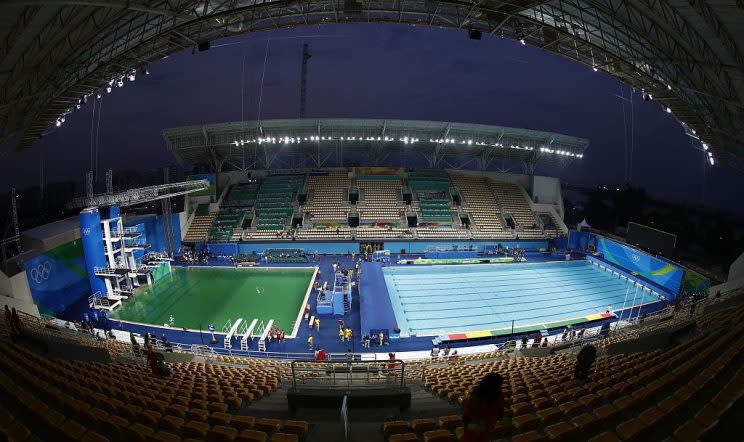Olympic officials explain icky green fart pools, threat to athletes

RIO DE JANEIRO – When your Olympics have been defined by super-viruses in the sailing venue and diseases carried by insects, having your diving, synchronized swimming and water polo pools turn a sickly, toxic green isn’t exactly the best look.
Or stench.
“The whole building smells like a fart,” said one German diver on Friday, as Rio Olympics officials cancelled practice and closed the pool at Maria Lenk Aquatics Centre for cleaning.
The mystery of the green pools has become one of the most glorious reservoirs of memes and conspiracy theories in the 2016 Games. Among them:
– Green ink from Rio Olympic signage seeped into the pool water.
– Athletes urinating en masse in the pool.
– Shrek farting in the pool, or as it’s also known, the most plausible theory.
So what turned the pools into giant tubs of Hi-C Ecto Cooler?
“We learned chemistry is not an exact science,” said Rio 2016 spokesman Mario Andrada.
The official line from the IOC is that they didn’t compensate for the number of athletes competing in the Games’ pools. “The alkaline levels went up because we had a far bigger number of athletes, so we didn’t use as many chemicals as we should,” said Andrada.
Now, this might sound idiotic, because how do the Rio Olympic organizers not know how many athletes are competing in, say, diving? Did they all invite friends to the pool party or something?
“We know how many athletes will be here,” said Andrada clarified. “But it’s not a scientific thing: What’s the impact on the pool on a given day. It’s impossible to figure out X amount of athletes using pool in X amount of minutes in the pool produce this specific thing.”
In other words, pool maintenance is an ever-changing task, and the Olympics didn’t have the right levels of chlorine to keep their water from turning into Kermit The Frog in liquid form.
And then they overcompensated.
“We made a little mistake,” said Andrada.

Rio Olympics officials confirmed that they pumped too much chlorine into the water polo pool this week, causing a dozen athletes to complain about irritated eyes. So while that might have seemed like the easiest fix, it created new problems.
“In the first day of the state of this water situation, one or two athletes complained about their eyes being itchy. This was a result of the first reaction to the water turning green, using more of the chemical chloride, which is very common in Olympic swimming pools. We reduced immediately the quantity. We retested the waters and found it was totally in the parameters,” said Andrada.
Tony Azevado, U.S. men’s water polo captain, said there were times he couldn’t see during their match against France this week.
“It doesn’t take a genius to know what they did to the pool, but it doesn’t matter,” he said on Friday. “We’ll play in green water, chlorinated water. I’m an American. All of our water is over-chlorinated.”
But not all of our water is bright green, which is why some athletes like British diving star Tom Daley were a little concerned when the pool was completely closed on Friday morning (it reopened for practice around 1 p.m. local time).
Diving pool is closed this morning. Hopefully that means we haven't been diving in anything too bad the last couple of days! ????????????
— Tom Daley (@TomDaley1994) August 12, 2016
Olympic officials continue to claim that the pea soup athletes are diving into isn’t dangerous to them.
“We reiterate what we’ve been saying all along. The water doesn’t hold any threat of the health of the athletes,” said Andrada. “All the doctors involved assured us there’s no risk to the athletes. The only thing that we had to do was cancel the training session.”
The pool was closed on Friday because officials said they needed “the water calm” in order to better clean it, and that while getting the water back to clear is the goal, “we can’t use too much chemicals because all the athletes are competing [in it].”
Well, yeah …
Despite the discoloration in the pools being yet another memorable “Rio Problem” from the 2016 Games, you have to give the organizers credit for one thing:
They did promise us the “greenest games” of all-time.
—
Greg Wyshynski is a writer for Yahoo Sports. Contact him at puckdaddyblog@yahoo.com or find him on Twitter. His book, TAKE YOUR EYE OFF THE PUCK, is available on Amazon and wherever books are sold.
Listen to Yahoo Sports’ Greg Wyshynski podcast from Rio on GRANDSTANDING, featuring U.S. swimming legend Summer Sanders on Michael Phelps, IOC doping and Donald Trump:

 Yahoo Sports
Yahoo Sports 

